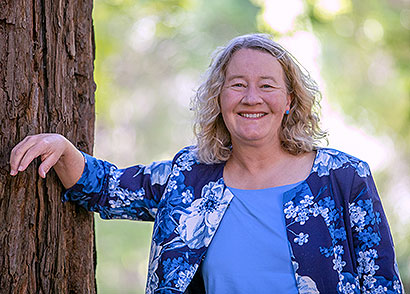“Telomeres” is just a fancy scientific term for “the ends of a chromosome.’’
These end-points are often compared to the plastic protective covers on the tips of shoelaces. Much biological research overlooked the lowly telomere, preferring to focus on the chromosome as a whole.
But telomeres play an oversized role in human health, with implications for bone marrow and cancer research. On Tuesday, Nobel laureate and UC Santa Cruz distinguished professor of molecular, cell, and developmental (MCD) biology professor Carol Greider delved deeply into those impacts during her fast-paced webinar, part of the Kraw Lecture series on science and technology.
Greider emphasized that many of the discoveries regarding telomeres were the end result of scientific curiosity.
“Curiosity-driven research provides unexpected discoveries that give us insight into biology,’’ Greider said. She and her colleagues in the science community did not set out to understand how shortened telomeres play a decisive role in bone marrow failure and pulmonary fibrosis. “We just wanted to know what happened when telomeres are not maintained,’’ she said. “By following our curiosity, we were able to understand these aspects of disease."
Greider’s technical knowledge and innovations have made her famous in the scientific community. She shared the 2009 Nobel Prize in Physiology or Medicine for her pioneering work on telomeres, the critical structures that maintain the ends of chromosomes, and the discovery of telomerase, the enzyme that maintains telomere length.
Before joining the UC Santa Cruz faculty this year, Greider, an eminent biologist and a staunch advocate for diversity in science, was the Bloomberg Distinguished Professor, Daniel Nathans Professor, and department director for Molecular Biology and Genetics at Johns Hopkins University School of Medicine.
Greider discovered telomerase as a graduate student in Elizabeth Blackburn’s laboratory at UC Berkeley.
She will establish a new laboratory at UC Santa Cruz to continue her telomere research program.
A guided tour through the telomere
Her breadth of experience will make her an invaluable asset to research on campus. But the Kraw Lecture showed that Greider also has a knack for science communication. In the hour-long talk, she was able to distill complicated truths that were legible even to those who had no idea telomeres existed at all, let alone play crucial roles in human life.
Telomeres are an essential part of the cell-division process. They are sections of DNA found at the ends of each of our chromosomes, and they consist of the same sequence of bases repeated over and over.
Without them, cell division would grind to a halt. Scientists have also found that the repeated divisions of cells gradually shortens the lengths of the telomeres. After several divisions, telomeres eventually become so short, stumpy, and compromised that a process known as “cell death’’ is triggered.
This degradation led to a scientific mystery: If telomeres lose their length and integrity with each cell division, how is it that life persists?
In other words, what, exactly, is making those cells keep on dividing even when the telomeres keep getting shrunken down?
Greider was part of the scientific team that figured out the answer: As it turns out, an enzyme called telomerase restores the missing telomere repeats back to the ends of chromosomes, compensating for the problem of gradual shortening.
Telomerase is essential for cancer cells’ rapid-fire division. This has prompted scientists to look into the possibility of shortening telomeres as part of cancer treatment. It makes a lot of sense on the surface; if you somehow disable an essential mechanism that helps cancer cells propagate before it’s too late, couldn’t you halt the cancer in its tracks?
Mice research has shown that this is indeed the case. Short telomeres can stop all cell division, including the division of cancer cells. But what happens to normal and healthy cells when telomeres are allowed to shrink down, without the intervention of telomerase? The implications can be dire.
The long and short of it
While shortened telomeres can arrest cancer growth, this same decline is also linked to health problems such as bone marrow failure as well as pulmonary fibrosis, a lung disease. Such problems can worsen over subsequent generations, Greider said. Insufficient immune function, emphysema predisposition, intolerance of chemo, liver cirrhosis, and GI disease are all linked to diminished telomere length. The progressive shortening of telomeres in cells over time also leads to prematurely gray hair and infertility of the testes, she said.
The health implications of telomere length shrinkage and telomere length maintenance create a conundrum for scientists. If the telomeres are continuously maintained, this can lead to cancer, but if they become too short, it can lead to stem cell failure.
“This makes us think very critically about what would happen if you shortened telomeres to treat cancer,” Greider said. “Would you put (patients) at risk for stem-cell failures? And if you treated degenerative diseases by maintaining telomere lengths, would you subject them to cancer risk? It helps us think about the implications of such interventions.”
Greider closed her talk with a word of caution about profiteers who are misinterpreting and misrepresenting telomere science to sell skin creams and other products that make dubious claims about sustaining youth. “My take home message is, don’t believe everything you read,’’ she advised. “Telomeres are important to age-related diseases, but a lot of people want to sell you things. You need to be skeptical.”



